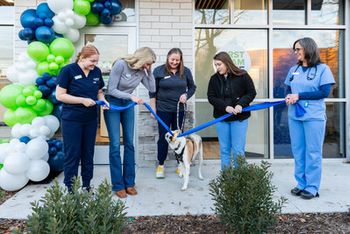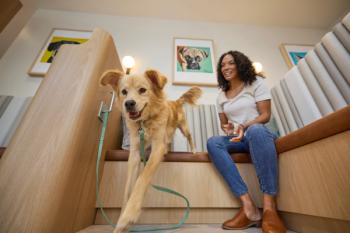
Make your unsightly exam room unbelievable
Our contest winner transformed an exam room. And you can do it, too.
Do you have an exam room that compromises your dignity? Do clients gawk and children giggle when they step into Room Three? You can remodel this terror of a room without creating chaos. Just ask the team at Great Neck Veterinary Clinic, Virginia Beach, Va., winner of the 2005 Veterinary Economics Ugly Exam Room Contest, sponsored by Veterinary Economics, BDA Architecture, Shor-Line Cabinet Co., and InPro Corp. Great Neck Veterinary Clinic realized it had a problem—and fixed it.
Perhaps it was when Dr. Blair Jones found herself crawling under the exam table to get to other items in the room that she realized it was time for a change. Or it could've been she finally tired of explaining "This was here before I got here."
"It became the running joke," she says. Only under the laughter, staff members weren't smiling.
The problem
"By the time you put two adults, two pets, a doctor, and assistant in the room, there was nowhere to move," says Dr. Gayle McHugh, an associate at Great Neck Veterinary Clinic. "The chair was opposite the door, but by the counter that had everything you needed. If a client sat down, you constantly had to reach over him or her. People were always crawling under the table to get to the other part of the room."
The configuration also made it difficult to work with big patients. "I'd hit my head on the table when I worked with big dogs," says Dr. Jones. "It was embarrassing—and the room just didn't represent the level of care we provide."
The heart of the problem: The clinic's ugly exam room used to be a kitchen. This clearly explains the two refrigerators and the oven fan—all things that made the room overcrowded.
"Often practices outgrow the two or three exam rooms they planned, and overnight or over a weekend they transform a kitchen—or some other room in the practice—to use as an exam room," says Wayne Usiak, AIA, a veterinary architect at BDA Architecture in Albuquerque, N.M. "You end up solving the pressing need for more space, but you're left with other problems because you didn't look at the issue holistically."
The exam room also had some serious cosmetic problems: the air-conditioner unit duct-taped in the window, bright green cabinets, golden-rod linoleum floor, and outdated wallpaper. Here are the steps the Great Neck team took to correct the problems.
Planning and progress
"Before we redid our room, we got together with our team and thought about elements we wanted to include and what we wanted the room to say about the hospital and the care we provide," says Dr. Jones.
A print of a cat by Dr. Jones' mother topped the list for the clinic's new room. "It's nice to incorporate such a personal element," says Dr. McHugh.
Next they chose cabinet and paint colors that coordinated with the print and meshed with their broader goals for the room. "Now each exam room at Great Neck Veterinary Clinic is a light pastel, and the new room is the yellow room," says Dr. McHugh. "We were trying to keep things bright and stimulating for the clients. And we wanted a positive work environment."
One way Great Neck Veterinary Clinic achieved that goal: They got everyone involved. "We let everyone participate in decisions," says Dr. McHugh. "The whole staff looked at samples for the cabinet and floor-tile colors. We all talked about what we wanted to include—a lift table, for example to work with heavy dogs."
When everyone weighed in, the team's key goals were to make the space more useable and to create a more professional atmosphere. Key project steps:
- Pull out the old cabinets and the old refrigerator.
- Hire a contractor to lay tile and re-surface and paint the walls and ceiling.
- Install new cabinets.
- Change the plumbing configuration to move the sink out from under the window. This change frees space for a veterinarian to work on one side of the exam table while an assistant helps from the other side. And the space still allows a small seating area for clients, says Wendy Wheeler, director of design at BDA Architecture. In addition, the team at Great Neck Veterinary Clinic put in a feline scale in the upper-drawer of a base cabinet.
The bumps in the road
The most difficult and frustrating part of remodeling the room was having it out of commission. "When you take on this kind of project, you just won't have enough space for a while," says Dr. McHugh. "It's frustrating when things are out of place and hard to find. The key is to keep everyone in the loop about what's happening when—and to remember that the end result will be worth it."
Sharing your plans helps fuel clients' understanding during the disruption, too. "Of course, we generally had to limit ourselves to the other two exam rooms," says Dr. Jones. "But when we could, we used the room in progress." She says that when the hospital staff explained what they were doing, clients understood and were happy about the plans.
In another effort to keep clients informed, the team held an open house to show off their work remodeling two other exam rooms and their plans for the contest-winning quarters. They displayed the contest call for entries and the new designs in the ugly exam room and made a big sign saying that the project was underway.
The hospital team organized a band and a cookout, and during the event, team members gave hospital tours. Despite a torrential downpour, people and pets came to see their work. "Our clients got a glimpse of our newest project, which made them feel more involved," Dr. Jones says.
Reaping the rewards
Now staff members at Great Neck Veterinary Clinic find the once-ugly exam room is one of the easier rooms to work in. "It's very sunny," Dr. Jones says. The bottom of the walls is white and the floor is gray tile—a big change from the outdated and noticeably aged, yellow linoleum vinyl flooring and dark, wood-panel walls that used to dominate the room.
"It started out as the room with the most limited work space," says Dr. Jones. "Now it's the biggest room, and we put all the big dogs in there!"
In fact, the team likes to leave the door wide open for everyone to see. And for the staff members, it's meant more efficiency and more confidence.
Dr. Jones knew the renovated room would be new and clean. "But I was surprised it could look so fancy and modern and yet retain the homey feel our practice strives for. After all, a lot of clients really like that our clinic is a comforting old house," Dr. Jones says.
"Ten percent of clients are sad the room changed; they miss the ugly green cabinets," says Dr. McHugh. "But most come in and say 'Wow, this looks so much better!' They're so pleased. Most of them felt it was long overdue but didn't want to say anything."
At the end of the day, Dr. Jones says clients' responses have been the most rewarding result of the project. "They associate the new look with a higher standard of medicine," she says.
Newsletter
From exam room tips to practice management insights, get trusted veterinary news delivered straight to your inbox—subscribe to dvm360.




